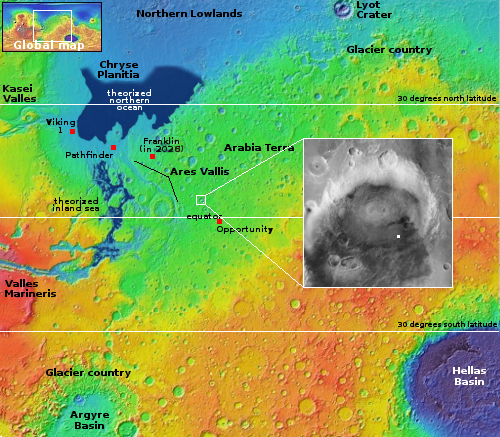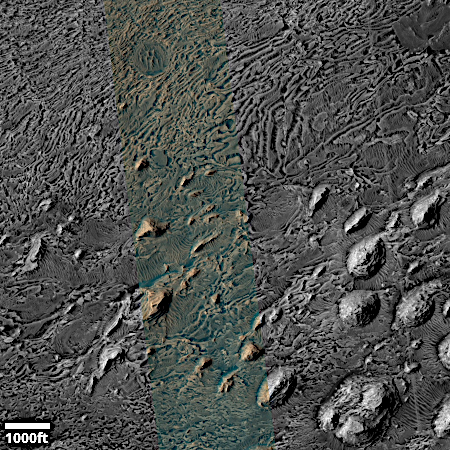Crazy layers inside a Martian crater
Cool image time! The picture to the right, cropped, reduced, and sharpened to post here, was taken on September 30, 2025 by the high resolution camera on Mars Reconnaissance Orbiter (MRO).
The scientists label this image with the term “layers”, but to my eye this is kind of an understatement. The geology in the top half of this picture is more than simply layers, it is an example of that unique Martian geological feature dubbed “brain terrain”, but on steroids.
No one yet knows what causes brain terrain, though scientists think it is related to the sublimation of near surface ice. Normally the tubelike formations are much smaller, only ten to thirty feet long, not hundreds of feet as we see here.
In this case the location of these features makes their formation even more puzzling, as there is no near surface ice found here.

The white dot on the overview map to the right marks the location, inside 70-mile-wide Crommelin Crater, known for having many such layers on its floor. The brain terrain seen here is at the low point of the crater floor, which is mostly filled with a high dominant central peak, not unlike Mount Sharp in Gale Crater where Curiosity is roaming. While the crater’s rims range from 4,000 to 7,000 feet in height, that central peak rises about 4,500 feet from this low point.
Crommelin Crater is near the equator, only about 314 miles from where the rover Opportunity landed, so we should not expect any near surface ice to be present. However, research has suggested that this and several other nearby craters might have once had lakes, groundwater, or even springs, thus suggesting the features we see there now are remnants of that wet environment.
Either way, this geology is typical of Mars, alien and nothing like what is found on Earth.
On Christmas Eve 1968 three Americans became the first humans to visit another world. What they did to celebrate was unexpected and profound, and will be remembered throughout all human history. Genesis: the Story of Apollo 8, Robert Zimmerman's classic history of humanity's first journey to another world, tells that story, and it is now available as both an ebook and an audiobook, both with a foreword by Valerie Anders and a new introduction by Robert Zimmerman.
The print edition can be purchased at Amazon or from any other book seller. If you want an autographed copy the price is $60 for the hardback and $45 for the paperback, plus $8 shipping for each. Go here for purchasing details. The ebook is available everywhere for $5.99 (before discount) at amazon, or direct from my ebook publisher, ebookit. If you buy it from ebookit you don't support the big tech companies and the author gets a bigger cut much sooner.
The audiobook is also available at all these vendors, and is also free with a 30-day trial membership to Audible.
"Not simply about one mission, [Genesis] is also the history of America's quest for the moon... Zimmerman has done a masterful job of tying disparate events together into a solid account of one of America's greatest human triumphs."--San Antonio Express-News
Cool image time! The picture to the right, cropped, reduced, and sharpened to post here, was taken on September 30, 2025 by the high resolution camera on Mars Reconnaissance Orbiter (MRO).
The scientists label this image with the term “layers”, but to my eye this is kind of an understatement. The geology in the top half of this picture is more than simply layers, it is an example of that unique Martian geological feature dubbed “brain terrain”, but on steroids.
No one yet knows what causes brain terrain, though scientists think it is related to the sublimation of near surface ice. Normally the tubelike formations are much smaller, only ten to thirty feet long, not hundreds of feet as we see here.
In this case the location of these features makes their formation even more puzzling, as there is no near surface ice found here.

The white dot on the overview map to the right marks the location, inside 70-mile-wide Crommelin Crater, known for having many such layers on its floor. The brain terrain seen here is at the low point of the crater floor, which is mostly filled with a high dominant central peak, not unlike Mount Sharp in Gale Crater where Curiosity is roaming. While the crater’s rims range from 4,000 to 7,000 feet in height, that central peak rises about 4,500 feet from this low point.
Crommelin Crater is near the equator, only about 314 miles from where the rover Opportunity landed, so we should not expect any near surface ice to be present. However, research has suggested that this and several other nearby craters might have once had lakes, groundwater, or even springs, thus suggesting the features we see there now are remnants of that wet environment.
Either way, this geology is typical of Mars, alien and nothing like what is found on Earth.
On Christmas Eve 1968 three Americans became the first humans to visit another world. What they did to celebrate was unexpected and profound, and will be remembered throughout all human history. Genesis: the Story of Apollo 8, Robert Zimmerman's classic history of humanity's first journey to another world, tells that story, and it is now available as both an ebook and an audiobook, both with a foreword by Valerie Anders and a new introduction by Robert Zimmerman.
The print edition can be purchased at Amazon or from any other book seller. If you want an autographed copy the price is $60 for the hardback and $45 for the paperback, plus $8 shipping for each. Go here for purchasing details. The ebook is available everywhere for $5.99 (before discount) at amazon, or direct from my ebook publisher, ebookit. If you buy it from ebookit you don't support the big tech companies and the author gets a bigger cut much sooner.
The audiobook is also available at all these vendors, and is also free with a 30-day trial membership to Audible.
"Not simply about one mission, [Genesis] is also the history of America's quest for the moon... Zimmerman has done a masterful job of tying disparate events together into a solid account of one of America's greatest human triumphs."--San Antonio Express-News



Not only are these formations larger than other “Brain Terrain” formations, but they have the advantage of being close to many like themselves, and are of strongly varying sizes. This may make them useful for building larger Martian settlements. Smaller, thinner, channels may be more easily roofed over, by little more than melted ice that is allowed to refreeze in layers thick enough (10m+) to provide quite good radiation shielding, while placing entrance facilities in those ice shields as they are built. Once that is done, then plastic for pressure vessels inside the channels can be made as aramids, for habitats of growing size, within a large area that can contain habitats for tens of thousands in this picture alone.
This is an advantage over even lava tube caves, in that one need not cut basalt rock to gain openings beyond skylight entrances. It is also a much larger obtained volume for habitats than lava tubes, even in full lava fields, would usually provide. Such levels of construction would depend on multiple small nuclear power plants in the area, and those thick walls of the channels can be used as shielding from radiation coming from them as well.